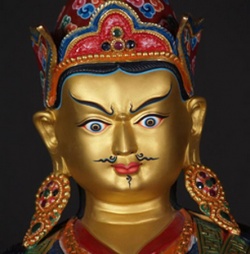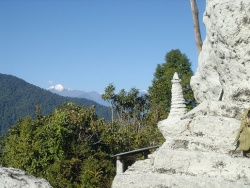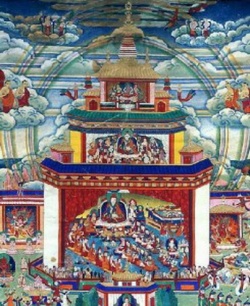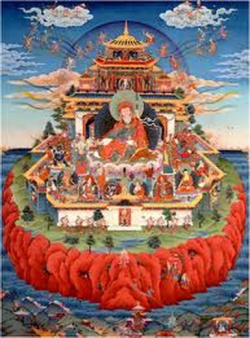In Quest of Shangri-La
Newsweek International, May 31, 1999
In every culture, there is this dream of some sanctuary where the best of civilization can be preserved.—Ian Baker
Shangri-La, the legendary paradise of the 1933 novel "Lost Horizon," is based on Tibetan Buddhist legends of mystical sanctuaries, called beyuls, hidden within secluded Himalayan valleys. Using directions deciphered from eighth-century Tibetan Buddhist texts, American explorer Ian Baker, 41, searched five years to find a route into the beyul of Pemako, in a wilderness region of eastern Tibet. On Nov. 8, 1998, he and two other Americans in his 10-man expedition reached a previously uncharted waterfall on Tibet's Tsangpo River. (The National Geographic Society, which sponsored the expedition, subsequently named Baker one of its six "Explorers for the Millennium.") A rock portal there leads into a mysterious valley, but Baker and the others were unable to enter it, and since then China has closed the area to further foreign exploration. In Katmandu, Baker talked about his quest for Shangri-La with NEWSWEEK's
Patricia Roberts. Excerpts:
ROBERTS: Why does the myth of Shangri-La endure?
BAKER: I think in every culture, there is this millennial dream of some kind of sanctuary where the best of civilization on every level can be preserved. That's what Shangri-La was. It was the "Valley of the Blue Moon," a place where time no longer existed in the way we think of it, where we could live for hundreds of years. The concept of Shangri-La had an impact, whether consciously or unconsciously, on a whole generation. The book came out between the two world wars, a time when civilization as it was known was suddenly in question.
Is the fictional Shangri-La based on an actual place?
The references for the book ["Lost Horizon"] came very clearly from reports made by explorers in the Tsangpo Gorge.
What motivated you to explore that particular area?
I was intrigued because I was approaching it more from the Tibetan literary and oral tradition than a purely geographical one. Tibetan texts, even though they're wildly visionary, are always based on something concrete. There is a description of three waterfalls, the middle one being described as a doorway, a portal into the inner, secret Pemako. It seemed to me that if this waterfall were so strong a feature of the landscape that they could envision it as a gateway to a hidden paradise, then this was a waterfall worth trying to find.
Actually, how do you get there?
You drive about three days east of Lhasa to a point halfway between the eastern border of Bhutan and the western border of Burma, right where the Tsangpo River makes a great bend and flows south into the jungles of Arunachal Pradesh. From there you walk days and days through any number of different passes that lead you over the eastern ramparts of the Himalayan range, down into this subtropical region off the Tibetan Plateau.
What are the major obstacles?
It's an extremely wet rain forest, full of leeches and pit vipers. The trails are seasonal; they often disappear. Camping is very difficult. Often we excavated for hours to make a place to put up a single tent. Some areas of Pemako have the densest population of Bengal tigers left in the world. There is one valley where yetis [Abominable Snowmen] are believed to be, and the people believe they're dangerous.
Is the area inhabited?
The local people are Lobas, fierce animistic warriors who were converted to Buddhism by early lamas. They live in little villages perched on high terraces above the Tsangpo. Poison cults [women who poison people in order to acquire their good fortune] are believed to be quite prolific in the area.
Your discovery has been challenged by other explorers. Are you certain
you were the first?
When we reached the falls we were aware that the Chinese were in the upper gorge, several miles upriver from us, and were going to attempt to go through this area. At the end of January an article came out in the China Daily titled "Chinese Explorers Reach Waterfall First." They may have seen this waterfall after us, but there's absolutely no question that they were not there before us.
The Chinese government closed the area after your expedition. Why?
The area had suddenly become known, and was being promoted as the "Mount Everest of Gorges." But a Chinese expedition reported in mid-December the area is full of incredible botanical riches and species that are unknown, and tourism could be disastrous for the environment.
If the area is opened again, will you return?
Absolutely. Apparently there are several routes into the inner paradise. The openings will only appear to the right person at the right time. The texts talk about periods of declining environmental conditions, many new diseases suddenly appearing and more crime and fighting. The forces of ignorance, greed and aggression will be magnified at a time when a sanctuary such as Pemako would be the essential support for a spiritual or contemplative life. So in many ways the time definitely seems to be right. And a lot of lamas have supported that. They say this is the dark age. It's when times are darkest that these hidden lands will be opened.



